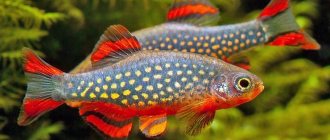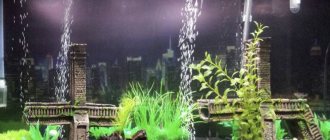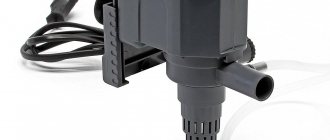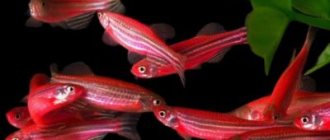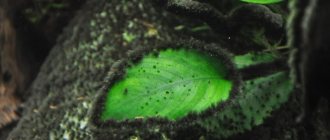The fish is also known by the names "Zebra Fish", "Striped Danio" and others. Over the years, breeders have developed new subspecies that differ in color, which can nevertheless interbreed, which leads to further speciation and blurring of the clear boundaries of one species/subspecies. The most famous varieties of Danio rerio are “Albino Danio”, “Leopard Danio”, “Golden Danio”, “Blue Danio”. There is also a genetically modified species that has a fluorescent element added to its genome, allowing the fish to glow in the dark. The fish first became commercially available in the United States in 2003.
Requirements and conditions:
- Aquarium volume - from 40 liters.
- Temperature - 18–24 °C
- pH value – 6.0–8.0
- Water hardness - soft to medium hard (5–19 dH)
- Substrate type - dark fine gravel or sand
- Lighting - dim
- Brackish water - no
- Water movement - moderate
Fish parameters:
- Size - up to 7 cm.
- Food - any food floating on the surface
- Life expectancy - from 3 to 4 years
Habitat
Danio rerio received a scientific description in 1822 during the study of the flora and fauna of the colonial possessions of the British Empire in the territories of modern India and Pakistan. The fish are widely represented in Asian river systems from Pakistan to India, including in Southeast Asia in Burma (Myanmar). The fish lives in the lower reaches of rivers, streams, canals, as well as in ditches near populated areas and ponds. The habitat can vary significantly depending on the time of year. During the rainy season, fish rush to flooded fields (in particular rice fields), where spawning occurs in a quiet backwater with dense vegetation. Adult fish return back to the rivers, followed by the emerging juveniles after a few days.
Appearance Features
Appearance of pink zebrafish:
- Dimensions . In its natural habitat it can grow up to 8 cm. When grown in an artificial reservoir, the length of an adult does not exceed 4-5 cm.
- The body is elongated and elongated, slightly compressed from the sides.
- The head is small and proportional, in perfect harmony with the body. There is a pair of antennae above the upper lip of the fish, giving it a funny look.
- Fins . The dorsal and anal fins are quite long and have a veil-like shape and a yellow-green color. A distinct pink stripe runs through the anal fin. The caudal fin is single, often colored bright scarlet.
- Color. The color is dominated by pink in its various variations with a bluish tint. The abdomen shimmers in the light with all the colors of the rainbow, which looks very impressive. Along the sides of the body there are bright red stripes, which gradually fade with age. A characteristic feature of the fish is that it acquires its color as it grows older. Individuals that have not reached sexual maturity have unremarkable gray-blue scales.
Sexual dimorphism. You can distinguish a male from a female by size and color. Males have a slimmer build and rich, brightly colored scales. In addition, the fins of males are longer and more developed. In females, upon reaching sexual maturity, the abdomen is noticeably rounded.
How long do they live?
The average lifespan of pink zebrafish in an artificial pond is about 8 years.
However, according to experts, with proper care and favorable living conditions, it can live up to 10 years.
Maintenance and care
Since the fish has lived in an artificial environment for many generations, it is well adapted to various conditions, so there are no problems in keeping it. It is enough to ensure good filtration and aeration of the aquarium; both of these processes also create water movement, which has a beneficial effect on Danio. The fish lives in the upper layers of water and leads an active lifestyle; during its games it can jump out of the aquarium - take care of the protective cover. Optimal conditions are those that mimic their natural habitat. Large spaces for swimming in the upper parts of the aquarium, dense vegetation on the sides along the walls. A substrate of dark gravel or sand will highlight the color of the fish.
Diseases
Like many inhabitants of home aquariums, all types of zebrafish practically do not get sick. For these creatures, clean water is important, so the aquarium must be equipped with an aerator. Pay attention to feeding the fish, since overeating often causes diseases of the digestive system. What other problems could zebrafish have?
Fading color
Zebrafish are shy. Shock received when transplanting to another aquarium (for example, when purchasing) can cause the color to fade. This problem is not that serious, but fish with the problem are kept in another container in quarantine.
Bug-eyed
Sometimes, while spawning, a zebrafish can get bulging eyes. Within 14 days, the eyes move out of their sockets and fall out. A blind fish cannot find food for itself and dies. The eye is pushed out of the orbit by a thick whitish mass that appears behind the eyeball (this formation was discovered when examining the corpse of a fish).
The cause of the disease is poor quality of the aquatic environment. To treat the disease, part of the water is changed regularly after 2 days.
Trichodinosis
The causative agent of trichodinosis in zebrafish is the ciliate Trichodina. With its spike-like processes, this organism attaches to the gills and surface of the fish.
The sick creature rubs against pebbles and algae and often approaches the area of aeration. As the disease progresses, the color of the fish becomes dull, a white or gray coating appears on the surface of the skin, which falls off in flakes.
To treat this disease, the tank is intensively aerated and the temperature of the aquatic environment is increased. In a separate container, you can arrange medicinal baths with sodium chloride (regular salt) or trypaflavin.
To prevent these miniature and funny fish from getting sick, all aquarium decor must be disinfected with a solution of potassium permanganate or hot boiled water before being added to the tank.
Social behavior
An active, peaceful fish, it has a peaceful temperament and never shows aggression towards other species. Shared keeping is possible with other species of Danio, as well as with some small (no more than 5–6 cm) peaceful species. You should be careful when choosing slow-moving fish; excessive activity of Danio Rerio can negatively affect their well-being. It is mandatory to keep at least 5 individuals in a flock; when kept alone or in pairs, the fish becomes lethargic and susceptible to various diseases.
Varieties of zebrafish
Zebrafish are classified according to external characteristics. Aquarists keep, breed and grow no more than a dozen basic varieties, and also produce hybrid individuals.
Popular types of zebrafish:
- Rerio - most often found in home aquariums. This fish is also called “lady’s stocking” for its characteristic coloring. The rerio has an original pattern on its body in the form of longitudinal blue stripes on a light yellow background. The fins are yellowish at the edges, slightly fringed.
- Dangila is one of the largest representatives of zebrafish (grows up to 9 cm), and also the most cocky. The second name is “olive”, given to it for the gray-green background of the body. There are dark spots behind the gill covers. A bizarre pattern runs along the body, consisting of spots and stripes edged with mother-of-pearl.
- Devario (Malabar) is a shiny silver fish. Blue stripes run from head to tail, between which the body is colored yellow. The fins on the belly are pinkish-red, and the fins on the back and tail are blue.
- Tinwini (“golden rings”) is the smallest representative of the species. It has a unique pattern in the form of longitudinal rows with black spots. The main background of the body is yellow. The transparent fins also have dark streaks.
- Danio leopard is a breeding variation of rerio. Only it is covered not with stripes, but with dots. There is a veil form of this species - when the fins grow longer than usual and resemble a veil.
- Khopra is a firefly. A miniature yellowish-orange fish with a shiny stripe on its spine. It glows in the dark, which is why it got its nickname. Quite an expensive and rare fish.
Danio Chopra.
Danio teenvini.
Danio rerio.
Malabar danio.
Leopard danio.
Danio dangila.
Breeding work is ongoing, and new varieties are appearing.
We looked at a small part of the most popular zebrafish species.
Breeding/reproduction
Sexual differences are weakly expressed, females are only slightly larger than males, body coloring is the same in both sexes. Danio Rerio often forms couples that last a lifetime, but that’s where the romanticism ends. Parental instincts are weakly expressed; they can happily eat their eggs and do not participate in raising offspring. A separate tank is required for spawning. The spawning aquarium can be small, 20–25 liters. The bottom should be strewn with balls with a diameter of 1 cm or gravel of similar size. Arrange plants in dense groups. The composition of the water can be similar to that in a general aquarium. When it is noticed that two fish constantly stay together, and one of them has a swollen abdomen, it means that the female will soon lay eggs. The female is transplanted into a separate tank first; the male joins only the next day. The stimulus for spawning is a rapid drop in temperature; you can pour a glass of cold water directly into the spawning aquarium - this is an imitation of the rainy season. The female releases the eggs directly into the water, and the male fertilizes them. Sinking to the bottom, they roll into the spaces between the soil particles and become inaccessible to their parents. At the end of spawning, the couple is returned back to the common aquarium, and the fry appear after 7 days.
Diseases
Many questions about zebrafish are raised by their maintenance during illness. Sometimes, despite good care, pets can get sick. Here is a description of characteristic diseases.
Plistophorosis
The disease begins with the appearance of white spots on the body of the fish, which turn into ulcerations. The fins are disheveled, the fish swims at an angle from 45 to 90 degrees, and is very exhausted. The aquarium needs to be disinfected and soil removed from it. A 5% solution of hydrochloric acid or bleach is suitable for disinfection. Fish need to be treated using food additives.
Medicines:
- Erythrocycline – 50 mg per liter of water.
- Trichopolum – 5 mg per liter of water.
- Methylene blue solution – 10 mg per liter of water.
Those fish whose condition worsens despite treatment should also be destroyed.
Trichodinosis
The source of the disease is ciliates. The fish rubs against plants and objects in the aquarium. The body is covered with flakes of gray plaque. Treatment consists of increased aeration of the tank. The water temperature rises to 31 degrees. Table salt is gradually added to the water (1 tablespoon per 10 liters). The recovery process for fish lasts from a week to a month. The salt concentration must be maintained until the aquarium inhabitants have completely recovered. Then, as the water in the aquarium is replaced, the water becomes less and less salty.
Feeding
Zebrafish have an unpretentious taste, although they love live food and quickly gain weight on it. It is necessary to alternate dry granulated (Malawi, Tetra Phyll) and natural food (bloodworm, brine shrimp, tubuli). The grains of food should be very small so that it is easy for the fish to swallow it.
The feed rate is determined as follows: for 5 fish, it is enough to throw food on the tip of a knife 2-3 times a day and observe. If the food was eaten within 10 minutes, the portion was selected correctly, otherwise it is reduced.
It is better to give your fish less food than to overfeed them. With regular overfeeding, the fish begin to get fat and die. In case of excess food, do not feed for a while and partially change the water.
